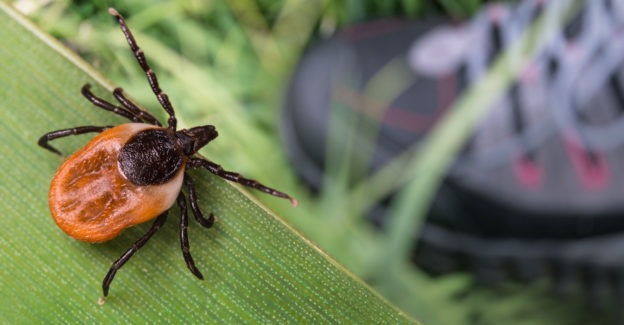Instructor
Elizabeth Maloney, MD
Education Co-Director, Invisible International
Description
Lyme disease is an increasingly common infectious disease in many regions of the U.S. Prompt diagnosis and treatment of early Lyme disease results in better outcomes. This presentation provides physicians with clinically relevant information that will enhance their diagnostic and management skills.
Learning objectives
- Make an early diagnosis by recognizing risk factors for and manifestations of early Lyme disease
- Discuss the pros and cons of different treatment options with patients
- Consider the following issues that may impact care: age, cultural beliefs, and co-morbidities
This session, Case studies in early Lyme disease, is approved for 1.0 enduring AAFP Prescribed credit.
AAFP Prescribed credit is accepted by the American Medical Association as equivalent to AMA PRA Category 1 credit(s)™ toward the AMA Physician’s Recognition Award. When applying for the AMA PRA, Prescribed credit earned must be reported as Prescribed, not as Category 1.
The AAFP has reviewed One Health Medical Education for a Changing Climate and deemed it acceptable for AAFP credit. Term of approval is from 01/02/2024 to 01/01/2025. Physicians should claim only the credit commensurate with the extent of their participation in the activity.
Disclosure information
In an effort to be transparent in our attempts to provide independent, unbiased educational content, we have received disclosure information from everyone who controlled content. None of the below planners, reviewers, and/or faculty have any financial relationships with commercial interests to disclose:
Planners
Christine Green, MD
Elizabeth Maloney, MD
Charlotte Mao, MD
Nev Zubcevik, DO
Judy Hyle, CHCP
Reviewers
William Choctaw, MD, JD
Michael Marchiano, MD
Lester Holstein, MD
Harold Damuth, MD
Evidence-based bibliography for further study
• http://www.cdc.gov/lyme/stats/chartstables/casesbyyear.html
• MMWR 2008; 57:SS 1-10.
• Hengge UR. Lyme Borreliosis. Lancet Infect Dis 2003;3(8):489-500.
• Tibbles CD, Edlow JA. Does this patient have erythema migrans? JAMA. 2007 Jun 20;297(23):2617-2627.
• Steere AC, Malawista SE et al. The clinical spectrum and treatment of Lyme disease. Yale J Biol Med 1984; 57(4):453-464.
• Duray PH, Steere AC. Clinical pathologic correlations of Lyme disease by stage. Ann NY Acad Sci 1988; 539:65-79.
• Hastey CJ Elsner RA, Barthold SW, Baumgarth N.Delays and diversions mark the development of B cell responses to Borrelia burgdorferi infection. J Immunol. 2012 Jun1;188(11):5612-5622.
• Hastey CJ, Ochoa J, Olsen KJ, Barthold SW, Baumgarth N. MyD88- and TRIF-independent induction of type I interferon drives naive B cell accumulation but not loss of lymph node architecture in Lyme disease. Infect Immun. 2014 Apr;82(4):1548-1558. doi: 10.1128/IAI.00969- 13.
• Pritt BS, Mead PS, Johnson DK et al. Identification of a novel pathogenic Borrelia species causing Lyme borreliosis with unusually high spirochaetaemia: a descriptive study. Lancet Infect Dis. 2016 Feb 5. pii: S1473-3099(15)00464-8. doi: 10.1016/S1473-3099(15)00464-8.
• Rudenko N. Golovchenko M, Grubhoffer L, et al. Updates on Borrelia burgdorferi sensu lato complex with respect to public health. Ticks Tick Borne Dis. 2011; 2(3):123-128.
• Krause PJ, Narasimhan S, Wormser GP, et al. Human Borrelia miyamotoi infection in the United States. N Engl J Med. 2013; 368(3):291-293.
• Khatchikian CE, Nadelman RB, Nowakowski J, et al. Public health impact of strain specific immunity to Borrelia burgdorferi. BMC Infect Dis. 2015 Oct 26;15:472. doi: 10.1186/s12879- 015-1190-7.
• Khatchikian CE, Nadelman RB, Nowakowski J, et al. Evidence for strain-specific immunity in patients treated for early lyme disease. Infect Immun. 2014 Apr;82(4):1408-1413.
• Embers ME, Ramamoorthy R, Philipp MT. Survival strategies of Borrelia burgdorferi, the etiologic agent of Lyme disease. Microbes and Infection 2004; 6:312-318.
• Wang G, Van Dam AP, Schwartz I, Dankert J. Molecular Typing of Borrelia burgdorferi Sensu Lato: Taxonomic, Epidemiological, and Clinical Implications. Clin Microbio Reviews 1999; 12(4):633-653.
• Yang X, Coleman AS, Anguita J, Pal U (2009) A Chromosomally Encoded Virulence Factor Protects the Lyme Disease Pathogen against Host-Adaptive Immunity. PLoS Pathog 5(3): e1000326. doi:10.1371/journal.ppat.1000326. Published March 6, 2009.
• Dykhuizen DE, Brisson D, Sandigursky S, et al. The propensity of different Borrelia burgdorferi sensu stricto genotypes to cause disseminated infections in humans. Am J Trop Med Hyg. 2008; 78(5):806-810.
• Kurtenbach K, Hanincová K, Tsao JI, Margos G, Fish D, Ogden NH. Fundamental processes in the evolutionary ecology of Lyme borreliosis. Nat Rev Microbiol. 2006 Sep;4(9):660-669.
• Grimm D, Tilly K, Byram R, Stewart P, Krum J, Bueschel D et al. Outer-surface protein C of the Lyme disease spirochete: A protein induced in ticks for infection of mammals. PNAS 2004; 101(9):3142-3147.
• Rosa PA, Tilly K, Stewart PE. The burgeoning molecular genetics of the Lyme disease spirochaete. Nature Reviews Microbio 2005; 3:129-143.
• Hovius JWR, van Dam AP, Fikrig E. Tick–host–pathogen interactions in Lyme borreliosis. Trends Parasitol 2007; 23(9):434-438.
• Lazarus JJ, Kay MA, McCarter AL, Wooten RM. Viable Borrelia burgdorferi Enhances Interleukin- 10 Production and Suppresses Activation of Murine Macrophages. Infection Immunity 2008; 76(3):1153-1162.
• Singh SK, Girschick HJ. Molecular survival strategies of the Lyme disease spirochete Borrelia burgdorferi. Lancet Infect Dis 2004;4(9):575-583.
• Moriarty TJ, Norman MU, Colarusso P, Bankhead T, Kubes P, et al. 2008 Real-Time High Resolution 3D Imaging of the Lyme Disease Spirochete Adhering to and Escaping from the Vasculature of a Living Host. PLoS Pathog 4(6): e1000090. doi:10.1371/journal.ppat.1000090
• Ohnishi J, Schneider B, Messer WB, Piesman J, de Silva AM. Genetic variation at the vlsE locus of Borrelia burgdorferi within ticks and mice over the course of a single transmission cycle. J Bacteriol 2003; 185(15):4432-41. Massarotti EM, Luger SW, Rahn DW, et al. Treatment of early Lyme disease. Am J Med 1992; 92:396-403.
• Maloy AL, Black RD, Segurola RJ Jr. Lyme disease complicated by the Jarisch-Herxheimer reaction. J Emerg Med. 1998 May-Jun;16(3):437-438.
• Steere AC.Treatment of the early manifestations of Lyme disease. Ann Intern Med, 1983. 99(1): 22-26.
• Strle F, Ruzic E, Cimperman J. Erythema migrans: comparison of treatment with azithromycin, doxycycline and phenoxymethylpenicillin. J Antimicrob Chemother. Oct 1992;30(4):543-550.
• Wormser GP, Ramanathan R, Nowakowski J, et al.. Duration of antibiotic therapy for early Lyme disease: a randomized, double-blind, placebo-controlled trial. Ann Intern Med 2003; 138:697- 704.
• Eppes SC, Childs JA. Comparative study of cefuroxime axetil versus amoxicillin in children with early Lyme disease. Pediatrics 2002; 109:1173-7117.
• Dattwyler RJ, Volkman DJ, Conaty SM, Platkin SP, Luft BJ. Amoxicillin plus probenecid versus doxycycline for treatment of erythema migrans borreliosis. Lancet 1990; 336:1404-1406.
• Dattwyler RJ, Luft BJ, Kunkel M, et al.. Ceftriaxone compared with doxycycline for the treatment of acute disseminated Lyme disease. N Engl J Med 1997; 337:289-294.
• Nadelman RB, Luger SW, Frank E, et al. Comparison of cefuroxime axetil and doxycycline in the treatment of early Lyme disease. Ann Intern Med 1992; 117:273-280.
• Luger SW, Paparone P, Wormser GP, et al. Comparison of cefuroxime axetil and doxycycline in treatment of patients with early Lyme disease associated with erythema migrans. Antimicrob Agents Chemother 1995; 39:661-667.
• Luft BJ, Dattwyler RJ, Johnson RC, et al. Azithromycin compared with amoxicillin in the treatment of erythema migrans: a double blind, randomized, controlled trial. Ann Intern Med 1996; 124:785-791.
• Massarotti EM, Luger SW, Rahn DW, et al. Treatment of early Lyme disease. Am J Med 1992; 92:396-403.
• Steere AC, Sikand VK. The Presenting Manifestations of Lyme Disease and the Outcomes of Treatment. N Engl J Med 2003; 348:2472-2474.
• Steere AC, Dhar A, Hernandez J, Fischer PA, Sikand VK, Schoen RT, et al. Systemic Symptoms without Erythema Migrans as the Presenting Picture of Early Lyme Disease. Am J Med 2003;114:58-62.


